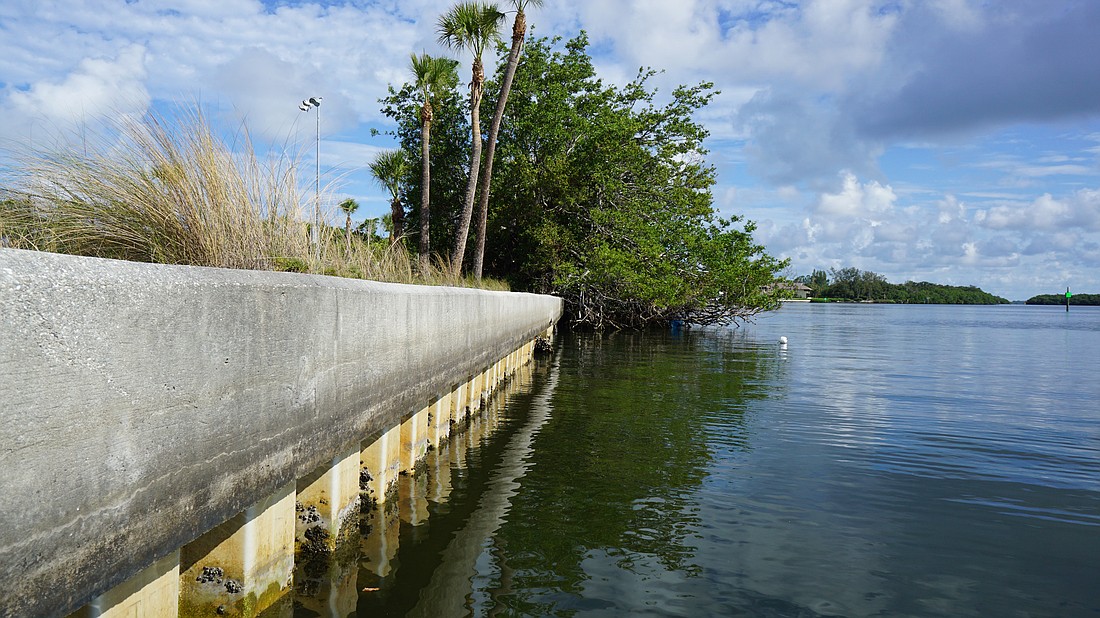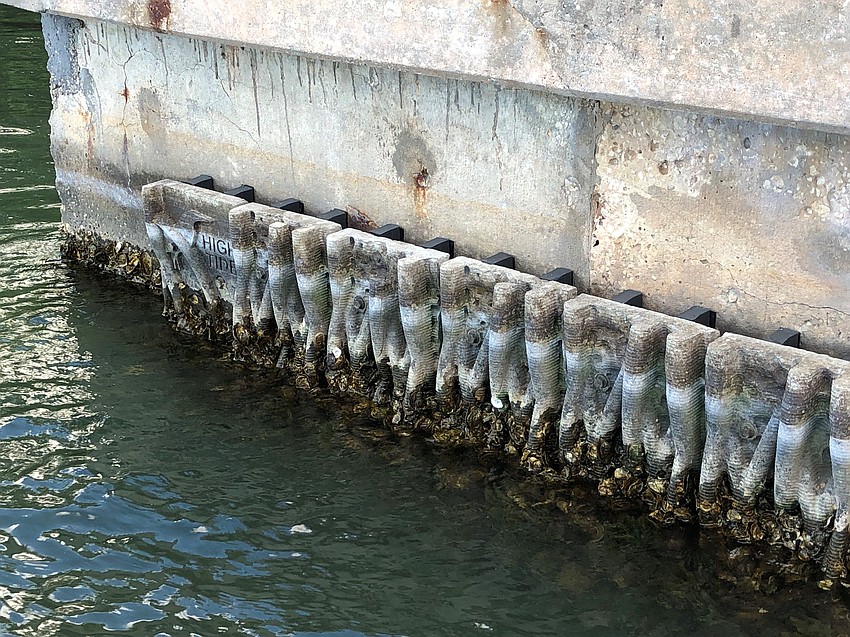- April 29, 2024
-
-
Loading

Loading

Vinyl sea walls protect many waterfront Longboat Key homes and canals, but they may not be as habitable for oysters as concrete sea walls. And that could be a problem for Sarasota Bay, because oysters help filter sea water.
In a recent small-scale study, Sarasota Bay Estuary Program Director Dr. Dave Tomasko and members of the SBEP observed 32 sea walls in the Sarasota Bay area, 16 concrete and 16 vinyl. Of the 16 concrete sea walls, all had a considerable amount of oysters growing on them. Only six of the 16 vinyl sea walls had any oysters attached, and had few compared to the number of oysters on the concrete sea walls.
“You could miss it if you weren’t carefully looking for it,” Tomasko said of the oyster presence on vinyl sea walls.
The two most common types of sea wall are concrete and vinyl, said Tomasko. Particularly in the south of Sarasota Bay, concrete walls are being replaced with the newer vinyl, or plastic, sea walls.
“It doesn't look like they have the same capacity to allow oysters to attach,” Tomasko said. “And so that is not a good thing for the bay.”
This is a problem because oysters are important filter feeders for the bay, said Tomasko. Losing oysters causes a loss in assimilative capacity, i.e. the ability for an environment to adapt to wastewater entering it. Most of this activity has to do with the intertidal zone, which is below the high-tide line and above the low-tide line.
Organizations like SBEP work to encourage the reduction of wastewater, fertilizer, grass clippings and other pollutants from entering the bay. But if at the same time there is a decrease in oysters and assimilative capacity, it undermines the organization's time and efforts, said Tomasko.
Tomasko and SBEP still aren’t sure why oysters seem to fail to attach to vinyl sea walls, but there are three possibilities. One could be that the vinyl sea walls are too smooth. The second reason could be because oysters primarily settle on other oysters or calcium carbonate surfaces like concrete. However, Tomasko said there are plenty of examples of oysters attaching to plastic structures that have been in the water for a long time, like plastic lawn chairs or the plastic liners on dock pilings.
If it’s not the plastic itself, then Tomasko said it could be some sort of additive such as a UV protectant that may be inadvertently killing off oysters that try to attach. It’s still early in the research process, so they don’t know, Tomasko said.
Tomasko said that vinyl sea walls may be increasing in popularity because they’re cheaper and may last longer. But he said more thought needs to be going into the potential ramifications of their use.
Slated for SBEP’s fiscal year 2024, the organization will work with the town of Longboat Key to reimagine the shoreline along Bayfront Park. The project is anticipated to cost $500,000 and will be funded via allocation from the federal Bipartisan Infrastructure Law.
There are two main parts to the shoreline project, Tomasko said.
The first will be to replace a portion of the crumbling sea wall along Bayfront Park. SBEP thinks there is enough area there to create a sloped living shoreline. This would involve a harder structure on the outside to break waves, and then a vegetated slope. Right now, the organization is still in the early planning stages.
The second aspect is with the vinyl sea wall at Bayfront Park. Rather than removing the sea wall, SBEP Staff Scientist Jay Leverone found “mangrove panels.” Made of marine-safe concrete, these panels are designed to create habitats for oysters and emulate the look of red mangrove roots, hence their name.

Keith Van de Riet, a professor at the University of Kansas, designed the mangrove panels.
More than 80% of the shoreline in the Sarasota and Longboat Key area is armored, mostly with sea walls, according to Van de Riet.
“It seems a missed opportunity that we haven’t created fringe reefs within canal environments to improve water quality and create habitat – not to mention reduce wave energy from boats,” Van de Riet said in an email.
He also said there's been success with mangrove panels in other areas like Lemon Bay and Fort Pierce.
Shorelines like the envisioned living shoreline at Bayfront Park need to plan for anticipated future sea level rise. According to Tomasko, it is anticipated that the average water level in 30 years will be what the current average high tide is now. The average high tide in 30 years will then be 9 inches higher.
Projects like the mangrove panels will allow SBEP to support the desired environmental changes while also not being too intrusive.
“We are supporting a variety of efforts by the citizens who desperately want to do something to improve water quality and provide habitat,” Leverone said. “We want to support legitimate, well-intentioned efforts.”